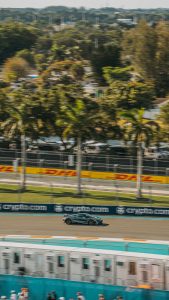Widgetized Section
Go to Admin » Appearance » Widgets » and move Gabfire Widget: Social into that MastheadOverlay zone
The Miami Formula One Grand Prix Successful Policy Process Through the Multiple-Streams Framework
The views expressed are those of the author and do not necessarily reflect the views of ASPA as an organization.
By Michael Turtz
May 30, 2025

The Miami Grand Prix in Formula One just completed its fourth year hosting the race at Hard Rock Stadium. The public policy origin of the race could be analyzed using Kingdon’s (Agendas, Alternatives, and Public Policies, 1984) Multiple-Streams (MS) Framework lens. The three streams include a problem stream, policy stream and political stream.
First, in the problem stream, there needed to be evidence that a problem exists. In 2018, the Miami Grand Prix was approved unanimously by the City of Miami Commission. This would be the second race in the United States, the first being the United States Grand Prix in Austin, Texas. The race in 2019 would have been located at the Port of Miami. However, the Port of Miami was not feasible due to construction costs, traffic, resident and business disruption.
Formula One’s Managing Director of Commercial Operations Sean Bratches and Tom Garfinkel, Vice Chairman and CEO of the Miami Dolphins and Hard Rock Stadium, decided to move the race to Hard Rock Stadium in 2021, located in the City of Miami Gardens. The Port of Miami is approximately 16 miles away from Hard Rock Stadium. In traffic, this could be approximately an hour away, completely changing the logistics of the race. Just as the race was approved by the City of Miami originally in the Port of Miami, the race would now have to be approved by the City of Miami Gardens. However, on October 29, 2019, the Miami-Dade County Board of Commissioners voted 7-6 against bringing Formula One to Hard Rock Stadium in Miami Gardens in 2021. Residents in Miami Gardens were in opposition to the event due to concerns about noise, traffic, pollution and safety.
The problem stream was two-fold: the first being that the original plan for the Port of Miami was not feasible to begin with, and second, the City of Miami Gardens voted against Hard Rock Stadium hosting the race in 2021. Kingdon referred to this as a focusing event – a disaster or crisis that draws attention to some conditions more than others. Kingdon’s problem stream mirrored that of the increasing international media coverage pushing the issue of when the actual race would occur in Miami since it was delayed several years.
The political stream was opened up by policy entrepreneurs – Tom Garfinkel and Stephen Ross, owner of the Miami Dolphins and Hard Rock Stadium. Policy entrepreneurs present solutions to policymakers, especially at the right time. They also use innovative ideas and strategies that are non-traditional to influence policy outcomes. After hearing the complaints by the City of Miami Gardens residents, Garfinkel and Ross, along with the Miami Dolphins Organization and Hard Rock Stadium, worked with the City of Miami Gardens on an innovative policy.
The policy stream opened up a year and a half later on April 14, 2021, when the City of Miami Gardens voted 5-2 in favor of the F1 race at Hard Rock Stadium being slated to begin in 2022. Mayor Rodney Harris was one of the five votes in favor of the motion. The technical proposal was from the Miami Dolphins Organization and Hard Rock Stadium through a Memorandum of Understanding (MOU) #21-052. The MOU included a benefits package at the time which would 1) not allow a race to start prior to 2:30pm on a school day, 2) not allow a race to start after sunset on any day, 3) install noise mitigation barriers, 4) carry out industry-standard air quality monitoring, and 5) commit $5 million in funding for City of Miami Gardens community benefits which included implementing STEM in schools, paid internships, and discounted tickets for residents.
Overall, Tom Garfinkel and Stephen Ross coupled the problem and political stream. The policy stream was opened by technical proposals from the Miami Dolphins Organization and Hard Rock Stadium. The intersection of all three streams occurred on April 14, 2021, a year and a half after the focusing event of the original vote on October 29, 2019. Coalition building was thorough and extensive, where the policy entrepreneur in this case had to be innovative and non-traditional in the MOU policy.
Currently, the Miami Grand Prix has a dedicated community program website which includes all of the City of Miami Gardens benefits package and statistics four years later. According to the Miami Times, in the first three years, the event has generated over $1 billion in economic impact throughout South Florida. They have partnered with more than 30 schools through STEM-focused education. They created the MIA Academy in 2023, which provides a direct pipeline for paid student interns in the City of Miami Gardens to become employed in areas such as communications, operations and marketing. Finally, they have provided 15 locally owned restaurants in Miami Gardens to serve fans throughout the race weekend. Overall, the MOU delivered economic and community results for the City of Miami Gardens and South Florida.
Author: Michael Turtz, MPA, is currently the Director of Administration at the Charles E. Schmidt College of Medicine at Florida Atlantic University. Michael is also currently a Ph.D. candidate in FAU’s School of Public Administration.


Follow Us!